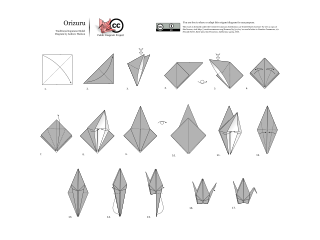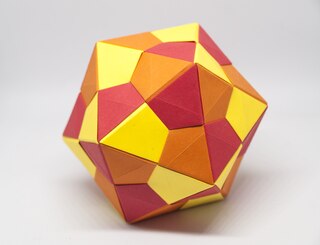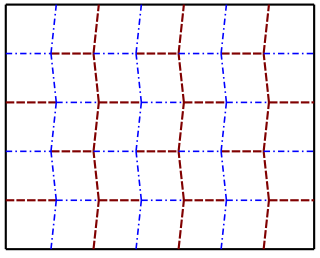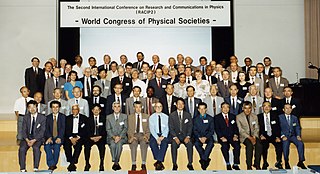
In mathematics, the four color theorem, or the four color map theorem, states that no more than four colors are required to color the regions of any map so that no two adjacent regions have the same color. Adjacent means that two regions share a common boundary curve segment, not merely a corner where three or more regions meet. It was the first major theorem to be proved using a computer. Initially, this proof was not accepted by all mathematicians because the computer-assisted proof was infeasible for a human to check by hand. The proof has gained wide acceptance since then, although some doubters remain.

Origami is the Japanese art of paper folding. In modern usage, the word "origami" is often used as an inclusive term for all folding practices, regardless of their culture of origin. The goal is to transform a flat square sheet of paper into a finished sculpture through folding and sculpting techniques. Modern origami practitioners generally discourage the use of cuts, glue, or markings on the paper. Origami folders often use the Japanese word kirigami to refer to designs which use cuts.

The Yoshizawa–Randlett system is a diagramming system used to describe the folds of origami models. Many origami books begin with a description of basic origami techniques which are used to construct the models. There are also a number of standard bases which are commonly used as a first step in construction. Models are typically classified as requiring low, intermediate or high skill depending on the complexity of the techniques involved in the construction.

The discipline of origami or paper folding has received a considerable amount of mathematical study. Fields of interest include a given paper model's flat-foldability, and the use of paper folds to solve up-to cubic mathematical equations.

Modular origami or unit origami is a two-stage paper folding technique in which several, or sometimes many, sheets of paper are first folded into individual modules or units and then assembled into an integrated flat shape or three-dimensional structure, usually by inserting flaps into pockets created by the folding process. These insertions create tension or friction that holds the model together.

The Miura fold is a method of folding a flat surface such as a sheet of paper into a smaller area. The fold is named for its inventor, Japanese astrophysicist Kōryō Miura.

Toshikazu Kawasaki is a Japanese paperfolder and origami theorist who is known for his geometrically innovative models. He is particularly famous for his series of fourfold symmetry "roses", all based on a twisting maneuver that allows the petals to seem to curl out from the center of the flower. Kawasaki also teaches mathematics at Sasebo Technical Junior College.

In graph theory, the hypercube graphQn is the graph formed from the vertices and edges of an n-dimensional hypercube. For instance, the cube graph Q3 is the graph formed by the 8 vertices and 12 edges of a three-dimensional cube. Qn has 2n vertices, 2n – 1n edges, and is a regular graph with n edges touching each vertex.

Kawasaki's theorem or Kawasaki–Justin theorem is a theorem in the mathematics of paper folding that describes the crease patterns with a single vertex that may be folded to form a flat figure. It states that the pattern is flat-foldable if and only if alternatingly adding and subtracting the angles of consecutive folds around the vertex gives an alternating sum of zero. Crease patterns with more than one vertex do not obey such a simple criterion, and are NP-hard to fold.

Rigid origami is a branch of origami which is concerned with folding structures using flat rigid sheets joined by hinges. That is, unlike in traditional origami, the panels of the paper cannot be bent during the folding process; they must remain flat at all times, and the paper only folded along its hinges. A rigid origami model would still be foldable if it was made from glass sheets with hinges in place of its crease lines.
The napkin folding problem is a problem in geometry and the mathematics of paper folding that explores whether folding a square or a rectangular napkin can increase its perimeter. The problem is known under several names, including the Margulis napkin problem, suggesting it is due to Grigory Margulis, and the Arnold's rouble problem referring to Vladimir Arnold and the folding of a Russian ruble bank note. Some versions of the problem were solved by Robert J. Lang, Svetlana Krat, Alexey S. Tarasov, and Ivan Yaschenko. One form of the problem remains open.
In graph theory, the De Bruijn–Erdős theorem relates graph coloring of an infinite graph to the same problem on its finite subgraphs. It states that, when all finite subgraphs can be colored with colors, the same is true for the whole graph. The theorem was proved by Nicolaas Govert de Bruijn and Paul Erdős (1951), after whom it is named.
In the mathematics of paper folding, map folding and stamp folding are two problems of counting the number of ways that a piece of paper can be folded. In the stamp folding problem, the paper is a strip of stamps with creases between them, and the folds must lie on the creases. In the map folding problem, the paper is a map, divided by creases into rectangles, and the folds must again lie only along these creases.
The Alexandrov uniqueness theorem is a rigidity theorem in mathematics, describing three-dimensional convex polyhedra in terms of the distances between points on their surfaces. It implies that convex polyhedra with distinct shapes from each other also have distinct metric spaces of surface distances, and it characterizes the metric spaces that come from the surface distances on polyhedra. It is named after Soviet mathematician Aleksandr Danilovich Aleksandrov, who published it in the 1940s.
Jun Maekawa is a Japanese software engineer, mathematician, and origami artist. He is known for popularizing the method of utilizing crease patterns in designing origami models, with his 1985 publication Viva Origami, as well as other paperfolding-related theorems and mathematical analysis. One of them being Maekawa's theorem in relation to the flat-foldability of origami models.

Kōji Husimi was a Japanese theoretical physicist who served as the president of the Science Council of Japan. Husimi trees in graph theory, the Husimi Q representation in quantum mechanics, and Husimi's theorem in the mathematics of paper folding are named after him.
Geometric Folding Algorithms: Linkages, Origami, Polyhedra is a monograph on the mathematics and computational geometry of mechanical linkages, paper folding, and polyhedral nets, by Erik Demaine and Joseph O'Rourke. It was published in 2007 by Cambridge University Press (ISBN 978-0-521-85757-4). A Japanese-language translation by Ryuhei Uehara was published in 2009 by the Modern Science Company (ISBN 978-4-7649-0377-7).
In the mathematics of paper folding, the big-little-big lemma is a necessary condition for a crease pattern with specified mountain folds and valley folds to be able to be folded flat. It differs from Kawasaki's theorem, which characterizes the flat-foldable crease patterns in which a mountain-valley assignment has not yet been made. Together with Maekawa's theorem on the total number of folds of each type, the big-little-big lemma is one of the two main conditions used to characterize the flat-foldability of mountain-valley assignments for crease patterns that meet the conditions of Kawasaki's theorem. Mathematical origami expert Tom Hull calls the big-little-big lemma "one of the most basic rules" for flat foldability of crease patterns.
Origami Polyhedra Design is a book on origami designs for constructing polyhedra. It was written by origami artist and mathematician John Montroll, and published in 2009 by A K Peters.











